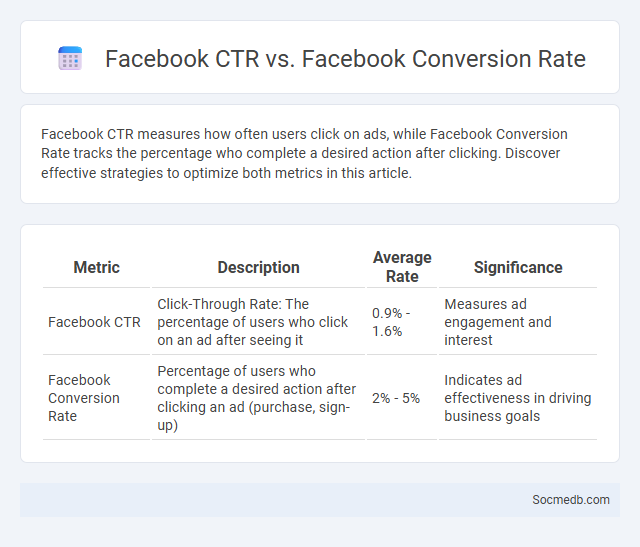
Photo illustration: Facebook CTR vs Facebook Conversion Rate
Facebook CTR measures how often users click on ads, while Facebook Conversion Rate tracks the percentage who complete a desired action after clicking. Discover effective strategies to optimize both metrics in this article.
Table of Comparison
| Metric | Description | Average Rate | Significance |
|---|---|---|---|
| Facebook CTR | Click-Through Rate: The percentage of users who click on an ad after seeing it | 0.9% - 1.6% | Measures ad engagement and interest |
| Facebook Conversion Rate | Percentage of users who complete a desired action after clicking an ad (purchase, sign-up) | 2% - 5% | Indicates ad effectiveness in driving business goals |
Understanding Facebook CTR: Definition and Importance
Understanding Facebook CTR (Click-Through Rate) is crucial for evaluating the effectiveness of your ad campaigns by measuring the ratio of users who click on your ad to the total number of impressions. A higher CTR indicates that your content resonates well with your target audience, leading to increased engagement and potential conversions. Optimizing Facebook CTR helps you maximize your advertising budget and improve overall campaign performance.
What is Facebook Conversion Rate?
Facebook Conversion Rate measures the percentage of users who complete a desired action, such as purchasing a product or signing up for a newsletter, after interacting with a Facebook ad. This metric is crucial for evaluating the effectiveness of Facebook advertising campaigns in driving user engagement and sales. Tracking conversion rates helps businesses optimize ad targeting, creative content, and budget allocation to maximize return on investment (ROI).
Click-Through Rate (CTR) Explained
Click-Through Rate (CTR) measures the percentage of users who click on a social media ad or link after seeing it, directly reflecting the effectiveness of your content in driving engagement. Higher CTR indicates compelling visuals and messaging that resonate with your target audience, while low CTR signals a need to optimize ad relevance and call-to-action strategies. Tracking CTR continuously helps you tailor your campaigns to improve user interaction and maximize return on investment.
Key Differences Between Facebook CTR and Conversion Rate
Facebook CTR measures the percentage of users who click on an ad after seeing it, reflecting initial engagement levels. Conversion rate tracks the proportion of users who complete a desired action, such as a purchase or sign-up, after clicking the ad, indicating the campaign's effectiveness in driving results. Understanding the gap between CTR and conversion rate helps marketers optimize ads for both attracting clicks and encouraging meaningful user actions.
How Click-Through Rate Impacts Facebook Ad Performance
Click-through rate (CTR) is a crucial metric that directly influences the cost-effectiveness and reach of your Facebook ads by determining how often users engage with your content. Higher CTR signals relevance to Facebook's algorithm, leading to improved ad placement and lower cost per click, maximizing your ad budget. Optimizing ad creatives and targeting strategies can significantly boost CTR, enhancing overall campaign performance.
Factors Influencing Facebook CTR
Facebook Click-Through Rate (CTR) is significantly influenced by factors such as ad relevance, audience targeting, and creative quality. Precise audience segmentation and tailored messaging increase engagement by matching user interests and behaviors. High-quality visuals and compelling call-to-actions further enhance CTR by capturing attention and encouraging user interaction.
Improving Your Facebook Conversion Rate
Enhancing your Facebook conversion rate requires targeted audience segmentation combined with compelling ad creatives that resonate with user intent. Utilizing A/B testing on ad formats, headlines, and call-to-actions helps identify the most effective strategies for your niche market. Leveraging Facebook Pixel data for retargeting campaigns increases engagement and drives higher conversion rates by focusing on users who have already interacted with your brand.
CTR vs Conversion Rate: Which Metric Matters More?
Click-Through Rate (CTR) measures how often users click on your social media ads, indicating initial interest, while Conversion Rate tracks the percentage of those users who complete a desired action, such as a purchase or sign-up. Your social media campaign's success relies more heavily on Conversion Rate because it reflects actual business outcomes beyond mere engagement. Optimizing for conversions ensures your marketing budget delivers tangible ROI rather than just driving traffic.
Common Mistakes When Analyzing Facebook Ad Metrics
Analyzing Facebook ad metrics often involves common mistakes such as overemphasizing click-through rates without considering conversion quality and ignoring the relevance score that impacts ad performance. Many advertisers fail to segment data by audience demographics, leading to misleading conclusions about campaign effectiveness. To optimize your strategy, focus on metrics like cost per action (CPA), return on ad spend (ROAS), and engagement quality, ensuring Your analysis reflects true business impact.
Best Practices for Optimizing Facebook CTR and Conversion Rate
To optimize Facebook CTR and conversion rates, use highly targeted audience segmentation based on demographics, interests, and behaviors to increase ad relevancy. Employ eye-catching visuals and concise, compelling ad copy with clear calls-to-action (CTAs) to drive user engagement and clicks. Continuously A/B test ad formats, headlines, and landing pages, while leveraging Facebook Pixel for precise tracking and retargeting to maximize conversion efficiency.
 socmedb.com
socmedb.com